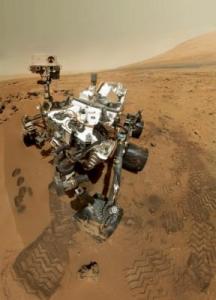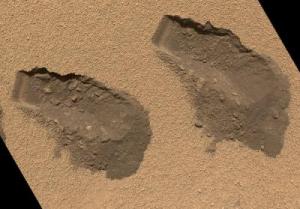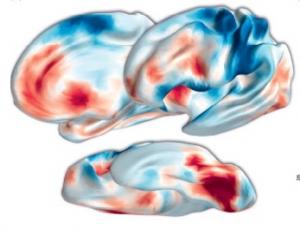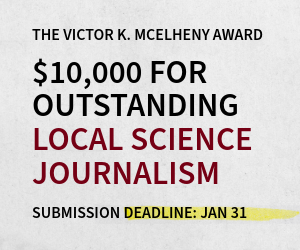On science blogs: Lost in Space
ORGANIC COMPOUNDS ON MARS! In our last episode, we were awaiting NASA's Monday press conference to find out for sure whether the Curiosity rover had found organic compounds — potentially evidence for life — on Mars. And indeed some of the early heds on pieces describing the press conference trumpeted the finding of Martian organics. Yet the official position is, ta-da: "we have no definitive detection of Martian organics at this point . . ."
So who's wrong? Nobody, sort of. A point of confusion is the word "organic." To most of us, the word means life or evidence thereof. But Emily Lakdawalla, who blogs in superior fashion at the Planetary Society, explains that to a space scientist, an organic compound is just something that contains carbon and hydrogen. She gives examples: "So carbon dioxide, diamond, and cyanides are not organic, but hydrocarbons (methane, ethane, propane, etc...) and alcohols and amino acids are." To reduce confusion, she suggests adopting a more specific term that does not (necessarily) imply life: carbon-containing compounds.
SAM, Curiosity's Sample Analysis on Mars instrument, did find organic compounds. What it found was chlorinated methane, which is by definition "organic" because it contains carbon and hydrogen. But chlorinated methane is not evidence of life, and it is quite possible that the carbon in it is a contaminant from Earth, carried to Mars by Curiosity itself.
At Cosmic Log, Alan Boyle reports that the NASA team first must determine that the carbon truly came from Mars. And even if it does prove to be Martian, did it arrive as "background fall of cosmic material?" Or is it residue from Martian chemical processes? Which might include life. But also might not. A great many ifs.
SAM also identified perchlorate, which is not organic because it consists of chlorine and oxygen. Perchlorate is toxic on Earth but, scientists speculate, might provide energy to microbes on Mars. The perchlorate discovery is not new, however. That compound was first found on Mars by the Phoenix lander in 2007.
Organics questions aside, setting up a mobile chem lab on Mars was a pretty neat trick. Lakdawalla's post, cited above, is really a tutorial about the workings of SAM, and John Timmer's Ars Technica post is also a SAM explainer.
MEANWHILE, MARS NEWS FROM HERE ON EARTH. NASA also announced another Mars rover mission this week, this one to launch in 2020. Perhaps reflecting recent budget cuts, the new rover will use the Curiosity design for its chassis and that very weird landing system that was both terrifying and unlikely but nevertheless worked perfectly. Eric Hand describes the planned mission at the Nature NewsBlog.
As Hand points out, this is not a pleasant surprise for the scientists who want to send rovers somewhere new, for example Jupiter's moon Europa, which has a tantalizing salt-water ocean. That trip would cost billions. Nor is it good news for those who are unhappy that NASA pulled out of planned joint projects with the European Space Agency. For a European view of this, including an analysis of NASA's US budgetary politics, see Babbage.
NASA's now-deleted joint ventures in Europe included a Mars rover that had been scheduled for 2018. Which leads Hand to wonder whether the newly announced 2020 rover isn't new at all, but simply the 2018 rover postponed. Babbage sheds light on that possibility, too.
NASA IS LOST IN SPACE, SAYS THE NATIONAL ACADEMY OF SCIENCES. While we're in conspiratorial mode, it crossed my mind to wonder whether the timing of the new Mars rover announcement could possibly maybe perhaps be an attempt to preempt news about a NASA-bashing report from the National Academy of Sciences that came out about the same time.
If so, it worked. The new rover got a lot of media attention and the report very little.
Seth Borenstein of the AP did his usual thorough job. It is perhaps not quite fair to call the NAS report NASA-bashing, since a major target is the Obama administration. It ordered NASA to get busy planning a manned project to an asteroid as a stepping-stone to shipping astronauts off to Mars. But an asteroid project has produced a big yawn at NASA, and it lacks enthusiasm in Congress and among the public too.
I found only a bit of blogging about the report. For a brief description, see Yudhijit Bhattacharjee at ScienceInsider. Lee Hutchinson has a long analytical-historical post at Ars Technica. For an inside-the-beltway view, see Jeff Foust's post at Space Politics followed by many comments.
THE BACKLASH AGAINST BRAIN PORN. Knight Science Journalism Tracker Deborah Blum has written a smart overview of the backlash against "brain porn" — the trend to oversimplify, misinterpret, and sometimes just plain misrepresent neuroscience research for pop-sci purposes (not to mention a pecuniary goal: selling books.) The perpetrators are science journalists, pop writers, and sometimes even neuroscientists themselves. Deb considers, analyzes, and links to recent backlash lit. [Full disclosure: I've known Deb for many years, and we are presently collaborating on a (non-writing) project.]
She also names the terrific bloggers who are leading the charge against brain porn. It's a small but choice collection. As a follow-up to her post, let me point out a few prime picks from their recent ruminations.
At Mind Hacks, Vaughan Bell describes a brain-imaging study that is apparently serious, although it's hard to believe it's not a very classy and elaborate spoof. [Not open-access. "What is the most interesting part of the brain?" TICS, 06 December 2012. doi:10.1016/j.tics.2012.10.010] The paper appeared in the latest issue of the very serious journal Trends in Cognitive Sciences, which is usually known by the unserious nickname TICS — one reason I'm a little uncertain about taking the paper itself seriously.
So while I hope the paper is real, I can't certify that. But whether or not, it's a blast. It shows the paper-publishing popularity of various brain areas via amalgamated fMRI images reported in cognitive science publications — and it also correlates their popularity with journal impact factors. The figure comprises, Bell says, a meld of nearly all fMRI images in the neuroscience lit published between 1985 and 2008, an idea that by itself boggles the mind. The diagram I'm reproducing here, he says
amounts to a career progression map of the brain. Studying the red areas are what’ll get you published in the best journals.
And there's more.
Neuroskeptic considers how The Onion makes fun of mental illness and decides that
The Onion's approach is to satirize the beliefs and perceptions that characterize psychiatric illness. The result is hilarious, but also insightful and, in a weird way, empathetic.
As Deb did, Scicurious considers the recent New Yorker piece analyzing brain porn. She approves the critique but wonders whether its observation that neuroscience has yet to find its Newton makes any sense.
If neuroscientific discoveries should not be simplified in their description, then neither should neuroscience as a discipline. Our field is complex, and many thousands, or millions, of little truths will have to come together before we come to a complete picture of the brain. And for those millions of little truths, you will need a million little scientists.
The Neurocritic analyzes the New Yorker piece too. But, he points out,
cognitive neuroscience is not the only guilty party here. All sorts of scientific findings are overhyped by the media, university press releases, even scientists themselves.
Good to be reminded that hype is not confined to just one branch of science. It's everywhere.






